At Artistry in Glass, we are occasionally privileged to restore objects of great value and antiquity. Here we had the opportunity to stabilize a historic 18th-century Mexican bulto of San José y Niño, purchased in Mexico City and brought in by a Tucson customer.
What is a bulto?
A bulto (originally revulto) is a three-dimensional folk-art statue of a saint, carved in wood and polychrome, made in the southwestern U.S. and Latin America in the 18th and 19th centuries.
Bultos originated in the Hispanic and Native American communities of Mexico and New Mexico in the late 1700s, and continue to be a key element of worship in the region. The sculptures are made of cottonwood, aspen, cedar, and other woods, and are often painted and dressed in cloth or leather garments.
Bultos (also called Santos) depict Christ, the Virgin, saints, or events like the crucifixion or resurrection. They are displayed in special niches in a church or a home where they share an intimate, interactive, relationship with their audiences. They act as intermediaries between believers and the sacred figures they represent.
Artistry in Glass restores a historic bulto
Our client purchased this valuable antique in Mexico City and received it with interesting damage to the face/head.
On close examination, we found that the break in the head was part of the original craftsmanship. The artist had split the carved head down along the natural grain of the wood in order to hollow out the eye sockets from the inside and inset glass eyes.
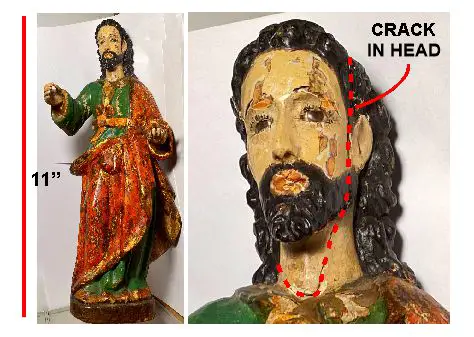
Vibration during transportation caused the head to separate along the original glued surface to reveal the interior workmanship:
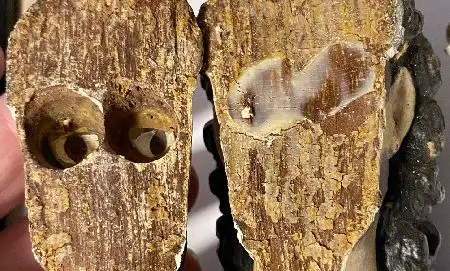
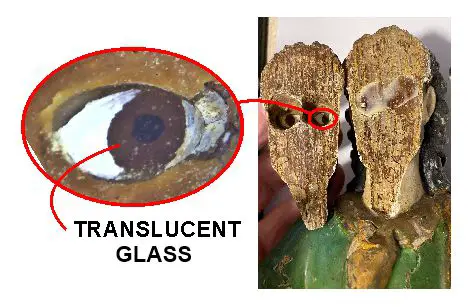
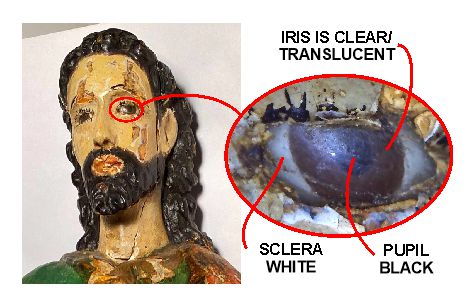
Glass was produced in Colonial Mexico, in Puebla, Jalisco, and Mexico City so it seems likely that these tiny eyes are made from locally-produced glass. The material is translucent and is decorated with white (sclera) and black (iris). A milky, organic material has been applied to the interior, opposite the eye sockets, to provide internal reflection and give the eyes depth and sparkle.
Age of the bulto
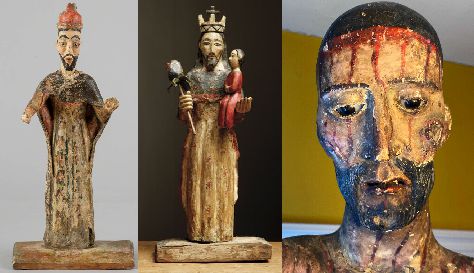
The San José y Niño is a very rare item and, by comparison with similar examples, is likely to be from the period 1780 -1820. Artistry in Glass is not qualified to give a firm date but our associated experts feel that bright red and green paint together with the gilding are likely to be later additions (painting touch-ups) because typical 18th-century painting was more subdued in tone and had a matte rather than a glossy finish.
Restoration of an antique crucifix bulto
Mexico and New Mexico also have a long tradition of large, articulated, and often bloody Crucifixion bultos. A santero usually carves a bulto with a knife or other wood carving tools, and then covers it with gesso, a mixture of native gypsum and glue, to prepare it for painting.
Our customer brought in this early 19th-century folk-art bulto for stabilization. As usual with antiques, the duty of the conservator is to maintain the original patina of the item and prevent further deterioration – without affecting the surface or re-painting.
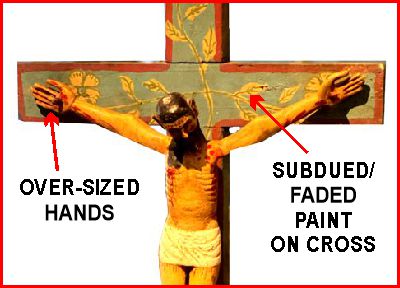
We make three small steel pins to re-attach the figure to the cross.
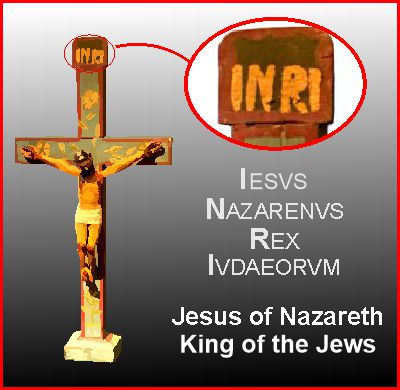
As an Amazon Associate, I earn from qualifying purchases
Contemporary artists especially in the Santa Fe area of New Mexico are still creating bultos for the tourist trade and modern manufacturers make a wide variety:
Handmade Crucifix Wall Cross
The crucifix continues to be a cherished object for home devotion as the principal symbol of the Christian religion in Catholic, Anglican, and Eastern Orthodox churches.
Artistry in Glass: your source for antique repair in Tucson
Check out these informative articles:-
- Where can I get antiques repaired?
- Are broken antiques worth fixing?
- How to fix a broken picture frame
- How to repair a broken china plate
- How to repair a broken china teapot
- How to fix a broken marble slab
- How to repair a broken china coffee mug
- How to repair a 2000-year-old sculpture
- All about repairing stained-glass lampshades
- How to care for your stained glass skylight
- How to repair Dalle de Verre
- Is stained glass worth repairing?
- To repair or toss out?
- What to do with broken antiques
- Is lead crystal dangerous?
- Repairing an antique Mexican statue
- Repairing religious statues
- The history of Swarovski crystal figurines
- How to find the value of a Swarovski Crystal figurine
- Have Swarovski figurines lost value since 2009?
- How to collect Swarovski annual ornaments
- How to display Swarovski crystal figurines
- How to authenticate a Swarovski crystal figurine
- How to display Swarovski annual ornaments
- How to clean Swarovski crystal figurines
- How to repair a Swarovski crystal mouse
- How to repair a Swarovski annual ornament
- How to repair a Swarovski crystal train set
- Fixing broken wine glass stems
- How to clean cloudy glasses
- Why do wine glasses have stems?
- Swarovski Crystal Figurines
- How to repair a chip in a wine glass
- How to fix a scratched glass tabletop
- How to replace a broken patio tabletop
Unique Mirror Resources from Artistry in Glass
Mirror Installation & Removal
- How to hang a wall mirror
- How to frame a builder’s grade bathroom mirror
- How to hang a frameless mirror with glue
- Best clips for hanging mirrors
- How to attach a mirror to a closet door
- How to remove a mirror glued to the wall

